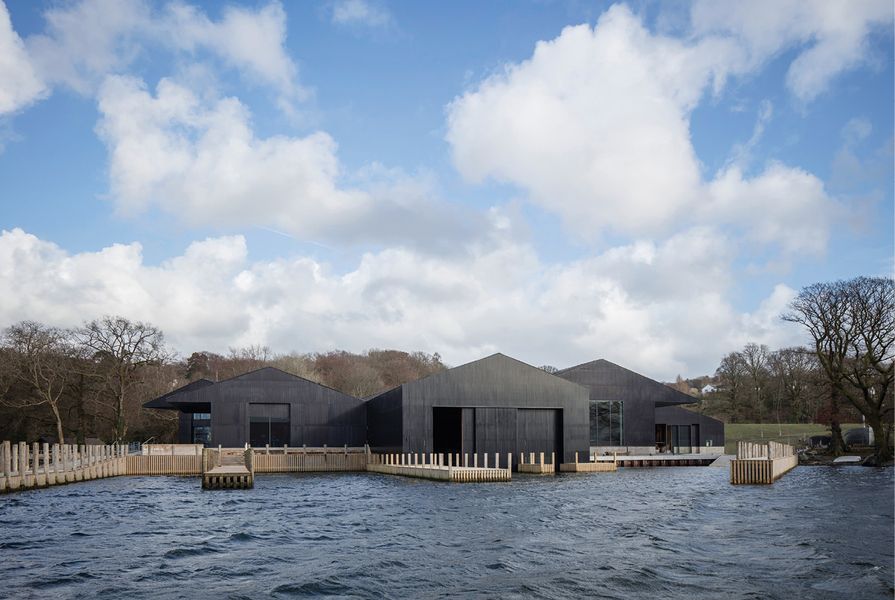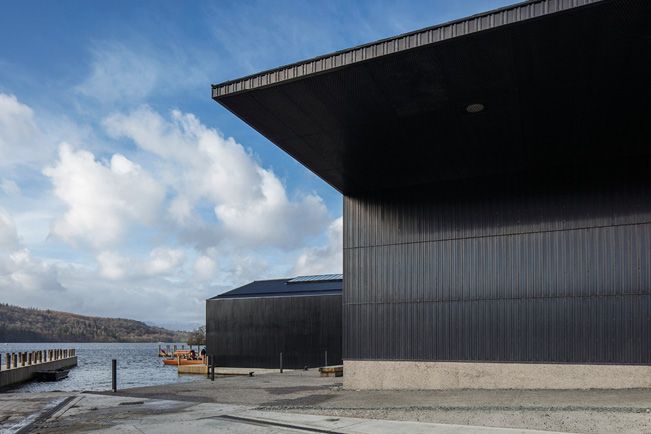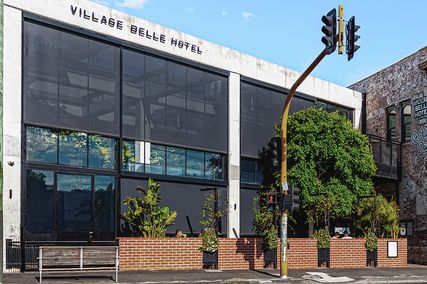A museum is normally a place that is separate from the world. It is where objects of significance are extracted from everyday use and kept safe for posterity. It is tightly secured and environmentally controlled in an attempt to slow the effects of light, temperature and humidity on the objects. A place of UV filters and glass cases to keep bright sun and greasy fingerprints at bay. But deprived of their context and use, are these objects also deprived of their power? What might a “living” museum look like?
The Windermere Jetty Museum of Boats, Steam and Stories, designed by Carmody Groarke, is one of these rare things. Stepping inside, I am struck by the smell of oil and sawdust, the creaking of boats bobbing in the water, people walking around in life jackets and overalls, the sound of a whistle as a ferry sets off, and a person at the reception desk wearing a captain’s hat. It’s a place that feels connected to the water, the landscape and the people that make up life here.
“Unlike a lot of museums that have a ‘do not touch’ policy, here you can really engage far beyond the visual experience,” explains Andy Groarke, who, with Perth-born and -raised Kevin Carmody, co-founded London-based architecture practice Carmody Groarke. “You can smell the beeswax and you can really hear the knock of the boats onto the jetties.”
Carmody Groarke’s design for the museum sought to hold the historical plurality of its location in equal balance with Windermere as a working lake.
Image: Christian Richters
The museum is located on the shore of Lake Windermere, England’s largest lake and part of the Lake District National Park. The lake is framed by steep hills that are dusted with snow in the winter, and natural forest that reaches down to the water’s edge. Since the eighteenth century, this dramatic landscape has been a centre for artists and writers. J. M. W. Turner painted here, drawn to the ever-changing atmosphere, and John Ruskin lived nearby toward the end of his life. Long a place for boating, in the nineteenth century Windermere became popular as a watery playground for wealthy industrialists and their elaborate steam-powered toys. Later, in the twentieth century, the long and narrow lake would serve as a course for attempts to break the world water speed record.
The museum was established in 1977 as the Windermere Steamboat Museum by local boat enthusiast George Pattinson in order to collect significant boats and tell their stories. Highlights include Beatrix Potter’s dinghy in which she used to sketch, the very handsome Branksome, a fifty-foot teak steam launch with an enclosed dining room, various speed machines from the 1960s and even a World War II-era aluminium glider with water hull.
Housed in a boatshed, the old museum was subjected to flooding and exposure to the elements and was unable to adequately look after the collection. In 2013, £13.4 million was secured by the museum to construct a new building. Carmody Groarke won the commission in an open international competition.
Carmody Groarke’s scheme sought to stitch together the various narratives of the place. “We were always keen to hold those histories – the picturesque, the art and literature, and the landscape – in equal balance with Windermere as a working lake,” says Groarke. The result is something between a modern municipal library and an industrial barn. It is comprised of five pitched-roofed blocks, shuffled together into an informal cluster, perched on the shoreline. “We felt a certain humility was needed to put a very big new museum into this natural context,” explains Groarke, “so rather than one big building, which the brief called for, we wanted to make a more granular form to break down the scale.” In places, the sides of the pitched blocks are cut away to form large undercrofts, further eroding the bulk of the building and preserving views of the water.
At the core of the Windermere Jetty Museum of Boats, Steam and Stories is a long shed, framed in exposed steel and Douglas fir rafters, where boats are displayed in the water.
Image: Christian Richters
The museum is conceived of in the round, to be seen and approached from all sides and even to be viewed from the hills above. Carmody Groarke proposed a single material to wrap the building’s walls and roof. Originally, the architects suggested stainless steel but, after working there in all four seasons, “we quickly realized that nothing is stainless,” says Groarke. Instead they looked at other natural metals that would register the passage of time and the effects of the elements. Inspired by Alvar Aalto’s National Pensions Institute in Helsinki of 1956, they developed a chemical cocktail with Arup’s metal specialists for a black oxidizing copper cladding. The material is dull but shiny, allowing it to reflect the changing sky, and it is beginning to capture the effects of the weather. The copper has been folded into vertical strips, like timber boards, and is divided by horizontal bands 1.8-metres high – the height of a person – breaking up the building’s bulk.
Inside, the pitched roofs form a series of naves oriented toward the water. These are wonderfully proportioned rooms with plenty of natural daylight, an ideal setting for the various boats and ephemera that make up the collection. In a clever moment of curation, two oil paintings of the lake from the 1780s – one calm, the other in a storm – hang beside a giant window that frames the real view of the scene. By looking from the two pictures to the lake beyond, Groarke describes experiencing a “real-time registration of the volatility of the environment,” connecting the museum to the world beyond its walls.
Full-scale boats, models, paintings, graphics, text and video are brought together with clear graphic signage, foregrounding the individual stories of the boats and the cultural context from which they came. A space for artists’ commissions invites contemporary perspectives to sit alongside historic ones.
Generously proportioned rooms, flooded in natural light, are an ideal setting for the various boats and ephemera that make up the museum’s collection.
Image: Christian Richters
At the centre of the museum is the wet dock, a long shed built over a cutting that allows boats to be displayed in the water. This is a “coats on” experience, open to the elements, where you can see how the boats sit while feeling the chill off the lake. The shed is framed in a combination of exposed steel and Douglas fir rafters. It is taut and refined, but still somehow relaxed. As Groarke explains, “it’s a building that looks crafted in its own way, but not fetishized; a building that looks as though it’s been put together with knowledge and the right techniques.” Beyond the shed is a working dock used by small craft and serving as a stop on the public ferry circuit around the lake, further blurring the boundaries between museum and life.
In a shed pulled off from the main cluster of buildings is the conservation studio, a workshop for restoring, repairing and maintaining the boats in the collection. When I visited, two red-vested conservators were fixing long boards to the inverted hull of a nineteenth-century steam launch as other boats sat in various stages of refinement, waiting for their turn. The conservation studio preserves the boats and, perhaps more importantly, all of the skills that come with their preservation – another moment in which the building reinforces the idea of the “living museum.”
This is an exceptional piece of architecture. It is generously composed, thoughtfully sited, elegantly detailed and beautifully made. It will serve this institution and its collection well for decades to come, introducing thousands of people to the history of the lake and the strange craft that once plied its waters. It not only preserves the physical evidence of this history but also, and above all, provides a space for these histories to live going forward.
Credits
- Project
- Windermere Jetty Museum
- Architect
- Carmody Groarke
United Kingdom
- Project Team
- Andy Groarke, Kevin Carmody (directors), Rowan Seaford (project architect), Ed Soden, Alex Stevens, Ross Tredget, Lewis Kinneir, Katrin Tacke, Araminta Sainsbury, Jack Mutton, Nora Heinzle, Justine Bell, James Taylor
- Consultants
-
Exhibition design
Real
Graphic design Apfel
Landscape design Jonathan Cook Landscape Architects
Structural & building services Ove Arup
- Site Details
-
Location
Lake District National Park,
United Kingdom
Site type Rural
- Project Details
-
Status
Built
Completion date 2019
Category Public / cultural
Type Museums
Source

Project
Published online: 28 Apr 2020
Words:
Rory Hyde
Images:
Christian Richters
Issue
Architecture Australia, January 2020

























